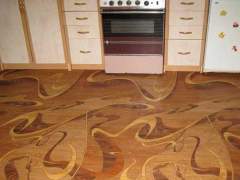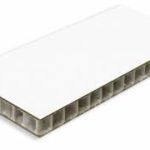The best material for kitchen floor. Review the most popular floorings and compare their advantages and disadvantages.
People spend much time in the kitchen, literally, it is the place in your house where your closest people get together every day. It is important to create the cozy atmosphere at your hearth-rug. We suggest starting from choosing the best material for the kitchen floor.
Main Characteristics Of Proper Kitchen Flooring Material
 Today the manufacturers offer lots of different floors covering options for the kitchen. However, some specific characteristics are the same for all floor coatings, regardless of the material you decide to use. So kitchen flooring of a proper quality has to be:
Today the manufacturers offer lots of different floors covering options for the kitchen. However, some specific characteristics are the same for all floor coatings, regardless of the material you decide to use. So kitchen flooring of a proper quality has to be:
- Impervious to wear and tear.
- Waterproof.
- Easy to clean with some basic household cleaning agents.
- Easy to maintain in good condition.
- Non-toxic itself and installed without using any toxic adhesives.
Optionally you have to choose floor covering which is:
- Easy to install.
- Easy to replace partially.
You have to consider all these requirements to select the material which both will be true to your salt and delight to your eyes for years.
Types of Kitchen Floor Coatings
Laminate. In simple terms, laminate is the flooring material made of three or more layers of engineered material. Available in large variety of colors, laminate usually imitates wood (i.e. cherry, walnut, cedar, etc).
Pros: Fair price, nice appearance, possibility of DIY installation (especially if you choose glueless laminate). Maintenance is easy and does not require using any specific cleaning solutions. The internal layer of the laminate is usually resistant to damages (scuffs, scrubs, etc).
Cons: Laminate is quite enduring, but it still becomes worn to the thread with the time, and once it starts to look dated, you will have to replace it, as there is no possibility to renew or refurbish laminate floor covering.
 Linoleum. Linoleum used in our days is a natural material, which consists of wood flour, resins, linseed oils and other inartificial ingredients.
Linoleum. Linoleum used in our days is a natural material, which consists of wood flour, resins, linseed oils and other inartificial ingredients.
Pros: The most affordable one between flooring materials. Linoleum comes in any color palette with any patterns and ornaments you can imagine. Non-porous, easy to clean.
Cons: Most probably you will have to hire professionals to install linoleum. Also, this floor coating fades in the sun and worn to the thread with time.
Vinyl. A synthetic material that can mimic more expensive materials, such as natural stone, solid wood, glazed tile, etc.
Pros: Reasonable price. Easy to maintain and patch in case of necessity. Also, vinyl is available in different designs. You can install it by yourself.
Cons: Vinyl is less durable than other materials. It is not resistant to scratches, it can bubble or dent within few years, sun rays make it fade.
Cork. Cork flooring is made of the oak bark (of its outer layer, to be specific). This eco-friendly material is popular today due to its affordability and good looking.
Pros: Cork is very nice on the touch thanks to its texture. It holds the warmth really well.
Cork is one of the few natural materials that resist mold and mildew.
Cons: Cork requires repeated maintenance; you will have to polish it with wax and reseal with special polyurethane on the regular basis. In opposite case, the dirt will leave dark spots on the floor and the flooring will fade.
 Wood. Wooden floor covering is made mainly of pine, oak, maple, less often of birch, cedar or walnut. Wooden flooring fits in any interior; it usually harmonizes with furniture perfectly.
Wood. Wooden floor covering is made mainly of pine, oak, maple, less often of birch, cedar or walnut. Wooden flooring fits in any interior; it usually harmonizes with furniture perfectly.
Pros: Eco-friendly and good looking floor coating which never comes out of fashion. Today many manufacturers cover the wooden floor with special protective agents, so it becomes resistant to mildew, rot, and pests.
Cons: Liquids can damage the wooden floor. Also, this coating can be scratched easily and sometimes the spills appear even on the solid wood. You will have to refinish the covering approximately once per 1-2 years.
Natural stone. Natural stone is considered to be the timeless classic variant of floor coating. Travertine, slate, limestone, granite or marble flooring each have unique texture and patterns.
Pros: Natural stone floor looks really stunning, it is classy and chic at the same time. This material is durable and not too difficult to maintain in good condition.
Cons: Natural stone is really expensive and flooring installation also costs a lot, comparing to other materials installation. Beside of that, natural stone is cold, so you will have to use under floor heating or put some throw rug on the floor (which is quite unpractical for the kitchen).
 Ceramic tile. Ceramic tile is the mix of clays, sand, and some natural additives fired in the glost kiln and glazed. It remains one of the most popular floor coatings during decades of years.
Ceramic tile. Ceramic tile is the mix of clays, sand, and some natural additives fired in the glost kiln and glazed. It remains one of the most popular floor coatings during decades of years.
Pros: Ceramic tile is available in mega amounts of colors and patterns. In general, glazed tile looks elegant. This material has the non-porous surface, so it is extremely easy to clean with almost any cleaning solution or just with warm water. If one tile is damaged, you can replace it without touching other ones.
Cons: It can crack if you drop something heavy (i.e. glass, frying pan, etc.) on it. Ceramic tile is also cold, so you’d rather need to heat the floor or cover it with the scatter rug.
Notice that water can make ceramic tile really gleg, so be careful and sop up the water from the floor immediately.



